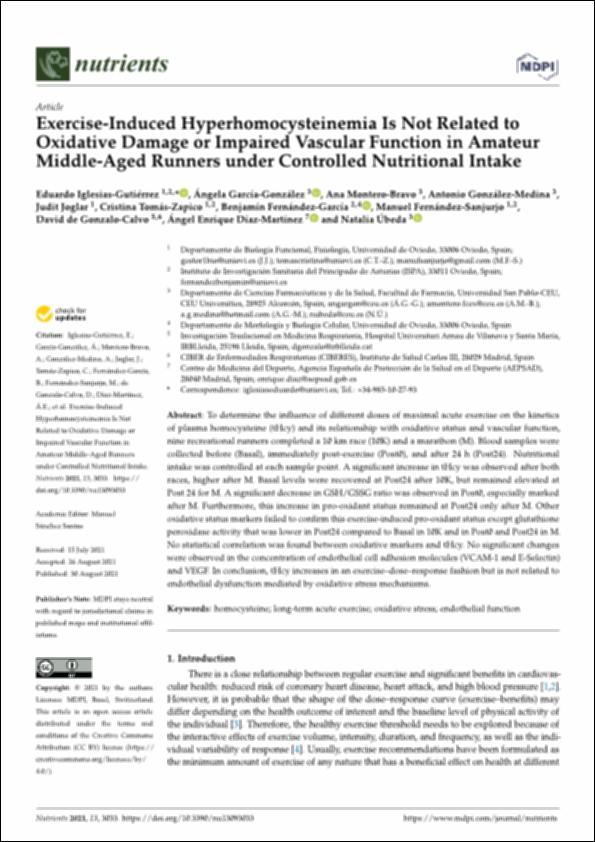Please use this identifier to cite or link to this item:
http://hdl.handle.net/10637/14985Exercise-Induced Hyperhomocysteinemia Is Not Related to Oxidative Damage or Impaired Vascular Function in Amateur Middle-Aged Runners under Controlled Nutritional Intake
| Title: | Exercise-Induced Hyperhomocysteinemia Is Not Related to Oxidative Damage or Impaired Vascular Function in Amateur Middle-Aged Runners under Controlled Nutritional Intake |
| Authors : | Iglesias Gutiérrez, Eduardo García González, Ángela Montero Bravo, Ana María González Medina, Antonio Joglar, Judit Tomás Zapico, Cristina Fernández García, Benjamín Fernández Sanjurjo, Manuel Gonzalo Calvo, David de Díaz Martínez, Ángel Enrique Úbeda Martín, Natalia |
| Keywords: | Homocysteine; Long-term acute exercise; Oxidative stress; Endothelial function |
| Publisher: | MDPI |
| Citation: | Iglesias-Gutiérrez, E.; García-González, Á.; Montero-Bravo, A.; González-Medina, A.; Joglar, J.; Tomás-Zapico, C.; Fernández-García, B.; Fernández-Sanjurjo, M.; de Gonzalo-Calvo, D.; Díaz-Martínez, Á.E.; et al. Exercise-Induced Hyperhomocysteinemia Is Not Related to Oxidative Damage or Impaired Vascular Function in Amateur Middle-Aged Runners under Controlled Nutritional Intake. Nutrients 2021, 13, 3033. |
| Abstract: | To determine the influence of different doses of maximal acute exercise on the kinetics of plasma homocysteine (tHcy) and its relationship with oxidative status and vascular function, nine recreational runners completed a 10 km race (10K) and a marathon (M). Blood samples were collected before (Basal), immediately post-exercise (Post0), and after 24 h (Post24). Nutritional intake was controlled at each sample point. A significant increase in tHcy was observed after both races, higher after M. Basal levels were recovered at Post24 after 10K, but remained elevated at Post 24 for M. A significant decrease in GSH/GSSG ratio was observed in Post0, especially marked after M. Furthermore, this increase in pro-oxidant status remained at Post24 only after M. Other oxidative status markers failed to confirm this exercise-induced pro-oxidant status except glutathione peroxidase activity that was lower in Post24 compared to Basal in 10K and in Post0 and Post24 in M. No statistical correlation was found between oxidative markers and tHcy. No significant changes were observed in the concentration of endothelial cell adhesion molecules (VCAM-1 and E-Selectin) and VEGF. In conclusion, tHcy increases in an exercise–dose–response fashion but is not related to endothelial dysfunction mediated by oxidative stress mechanisms. |
| URI: | http://hdl.handle.net/10637/14985 |
| Rights : | OpenAccess http://creativecommons.org/licenses/by-nc-nd/4.0/deed.es |
| ISSN: | 2072-6643 |
| Issue Date: | 30-Aug-2021 |
| Center : | Universidad San Pablo-CEU |
| Appears in Collections: | Facultad de Farmacia |
Items in DSpace are protected by copyright, with all rights reserved, unless otherwise indicated.


